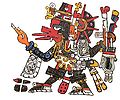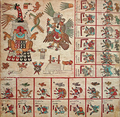Painting in the Americas before European colonization: Difference between revisions
listing oldest paintings in North and South America with refs, +wikilinks |
|||
| Line 133: | Line 133: | ||
*[http://www.teachers.ocps.net/moa/ ''A Virtual Reality Tour of Pre Columbian Art''] |
*[http://www.teachers.ocps.net/moa/ ''A Virtual Reality Tour of Pre Columbian Art''] |
||
* [http://astro.temple.edu/~dcm/teo.htm Teotihuacan Research Guide], academic resources and links, maintained by Temple University |
* [http://astro.temple.edu/~dcm/teo.htm Teotihuacan Research Guide], academic resources and links, maintained by Temple University |
||
* [http://jqjacobs.net/mesoamerica/teotihuacan.html Teotihuacán Photo Gallery] |
* [http://jqjacobs.net/mesoamerica/teotihuacan.html Teotihuacán Photo Gallery] |
||
* [http://studentweb.tulane.edu/~dhixson/teo/teo.html Mesoamerican Photo Archives: Teotihuacán], by David Hixson |
* [http://studentweb.tulane.edu/~dhixson/teo/teo.html Mesoamerican Photo Archives: Teotihuacán], by David Hixson |
||
* [http://authenticmaya.com/maya_culture.htm Maya Culture] |
* [http://authenticmaya.com/maya_culture.htm Maya Culture] |
||
* [http://jqjacobs.net/mesoamerica/teo_murals.html Teotihuacan Mural Art: Assessing the Accuracy of its Interpretation] |
|||
{{Pre-Columbian}} |
{{Pre-Columbian}} |
||
Revision as of 04:49, 3 November 2009
| Part of a series on |
| European colonization of the Americas |
|---|
 |
|
|
Painting in the Americas Before Colonization was a relatively widespread, popular and diverse means of communication for both religious and utilitarian purpose throughout the regions of the Western Hemisphere. During the period before and after European exploration and settlement of the Americas; including North America, Central America, South America and the islands of the Caribbean, the Bahamas, the West Indies, the Antilles, the Lesser Antilles and other island groups, indigenous native cultures produced creative works including architecture, pottery, ceramics, weaving, carving, sculpture, painting and murals as well as other religious and utilitarian objects.
The oldest known paintings in the South America are the cave paintings of Caverna da Pedra Pintada, in the Brazilian Amazon rainforest that date back 11,200 years.[1] The earliest known painting in North America is the Cooper Bison Skull found near Fort Supply, Oklahoma, dated to 10,200 BCE.[2]
Painting in the Americas Before Colonization
Each continent of the Americas hosted societies that were unique and individually developed cultures; that produced totems, works of religious symbolism, and decorative and expressive painted works. African influence was especially strong in the art of the Caribbean and South America. The arts of the indigenous people of the Americas had an enormous impact and influence on European art and vice-versa during and after the Age of Exploration. Spain, Portugal, France, The Netherlands and England were all powerful and influential colonial powers in the Americas during and after the 15th century. By the 19th century cultural influence began to flow both ways across the Atlantic.
The murals of Teotihuacan that adorn the archaeological site (and others, like the Wagner Murals, found in private collections) and from hieroglyphic inscriptions made by the Maya describing their encounters with Teotihuacano conquerors are the source of most of what is understood about that ancient civilization. The painting of the murals, perhaps thousands of them, reached its zenith between 450 and 650 CE. The painters' artistry was unrivalled in Mesoamerica and has been compared with that of Florence, Italy.[3]
The Great Goddess
A series of murals were found in the Tepantitla compound in Teotihuacan. In 1942, archaeologist Alfonso Caso identified the central figures as a Teotihuacan equivalent of Tlaloc, the Mesoamerican god of rain and warfare. During the 1970s researcher Esther Pasztory re-examined the murals and concluded that many paintings of "Tlaloc" instead showed a feminine deity, an analysis based on a number of factors including the gender of accompanying figures, the green bird in the headdress, and the spiders seen above the figure.[4] Pasztory concluded that the figures represented a vegetation and fertility goddess that was a predecessor of the much later Aztec goddess Xochiquetzal.
The Great Goddess has since been identified at locations other than Tepantitla – including Teotihuacan's Tetitla compound, the Palace of the Jaguars, and the Temple of Agriculture – as well as on several vessels.[5]
The Temple of the Murals
Large painted Mayan murals were found in the archaeological site Bonampak, in the Mexican state of Chiapas near the border with Guatemala. What is referred to as The Temple of the Murals is a long narrow building with 3 rooms atop a low-stepped pyramid base. The interior walls preserve the finest examples of classic Maya painting. Huge paintings cover the walls of one of the structure's three rooms. The paintings show the story of a single battle and its victorious outcome. [6]
-
Great Goddess mural from the site at Teotihuacán, Mexico
-
A portion of the actual mural from the Tepantitla compound which appears under the Great Goddess portrait, Mexico
-
Mural from the Tepantitla compound showing what has been identified as an aspect of the Great Goddess of Teotihuacan, from a reproduction in the National Museum of Anthropology in Mexico City
-
Jaguar mural from the site at Teotihuacán, Mexico
-
A Mayan mural from Guatemala, Pre-Classical period (1–250 AD)
-
Painting on the Lord of the jaguar pelt throne vase, a scene of the Maya court, 700-800 AD.
-
A Mayan mural from Bonampak, Mexico, 580–800 AD.
-
A Mayan mural from Bonampak, 580–800 AD
-
Painting from a Maya codex
-
Painted pottery figurine of a drunkard from the burial site at Jaina Island, Mayan art, 400–800 AD.
-
Painted relief of the Maya site Palenque, featuring the son of K'inich Ahkal Mo' Naab' III (678–730s?, r. 722–729).
-
An Aztec painting from the Codex Borgia
-
An Aztec painting from the Codex Borbonicus
-
Detail from the Battle Mural, c.600-700, Cacaxtla, Mexico
-
A painting from Codex Mendoza showing elder Aztecs being given intoxicants, Mexico, c.1553
South America
Nazca culture
The Nazca culture of Peru produced painted pottery and painted ceramics depicting religious and symbolic characters as well as imagery of personages within the culture. [7]They produced in addition to ceramics, highly complex textiles and Geoglyphs. The period from 1-700 A.D is generally considered when this group thrived. Modern knowledge about the culture of the Nazca is built upon the study of Cahuachi the ceremonial center from (1-500 AD).
-
Painted pottery from the Huari culture of Peru, 500–1200 AD
-
Peruvian Calabas, c. Pre-Columbian
-
Body painting, Indigenous peoples in Brazil, a Brazilian Indian couple, c.2000
North America
United States
In the area that is now the United States many different and diverse tribes of people created painting and ornamental painted objects of a large variety. The Pueblos from the Southwestern region of what is now the USA are believed to be descended from the three major cultures that dominated the region before European contact. The Mogollon, also believed to be related to the Zuni and Hopi tribes lived in an area near the Gila Wilderness, populated today by the Apache. The Fremont, the Patayan, and the Hohokam, are archaeological terms for the prehistoric people who formed settlements in the Southwest. Casa Grande Ruins National Monument is the best known monument of Hohokam culture. Like the modern day Zuni and Hopi tribes and the mysterious Ancient Pueblo Peoples or the Anasazi, a term coined by the Navajos describing an ancient culture that has since disappeared, the Fremont, the Hohokam and the Patayan formed villages and settlements. [8].
-
The Great Gallery, Pictographs, Canyonlands National Park, Horseshoe Canyon, Utah, 15 feet by 200 feet, c. 1500 BCE
-
Painted pottery, Anasazi, North America: A canteen (pot) excavated from the ruins in Chaco Canyon, New Mexico, c. 700 AD–1100 AD
-
Painted ceramic jug showing the underwater panther from the Mississippian culture, found at Rose Mound in Cross County, Arkansas, c. 1400-1600.
-
A Haida wolf mask, 1880.
-
A girl from the Zuni tribe of New Mexico with a painted pottery jar, photographed in c. 1903.
-
Navajo man in ceremonial dress with mask and body paint, c. 1904
-
An Uncompaghre Ute, Shaved Beaver Hide Painting. The Northern Ute would trap beavers, shave images into the animals' stretched and cured hides, and use them to decorate their personal and ceremonial dwellings, c. 19th century.
-
Tlingit totem pole in Ketchikan, Alaska, circa 1901.
-
The K'alyaan Totem Pole of the Tlingit Kiks.ádi Clan, erected at Sitka National Historical Park to commemorate the lives lost in the 1804 Battle of Sitka.
-
Fish mask of the Yupi'k people, painted wood, Yukon/Kuskokwim region Alaska, c. early 20th century
-
From Saxman Totem Park, Ketchikan, Alaska
-
From Saxman Totem Park, Ketchikan, Alaska
Canada
-
A totem pole in Totem Park, Victoria, British Columbia.
-
From Totem Park, Victoria, British Columbia.
Caribbean
See also
- Art history
- Aztec clothing
- Cascajal Block
- Indigenous peoples of the Americas
- History of painting
- History of the Americas
- List of indigenous artists of the Americas
- Maya script
- Mississippian culture
- Native American art
- Native Americans in the United States
- Timeline of Native American art history
- Western art
- Western painting
- Pictogram
References
- ^ Wilford, John Noble. Scientist at Work: Anna C. Roosevelt; Sharp and To the Point In Amazonia. New York Times. 23 April 1996
- ^ Bement, 176
- ^ Davies, p. 78.
- ^ Pasztory (1977, pp.83–85).
- ^ Pasztory (1977, pp.87–91).
- ^ Coe, Michael D. (1999). The Maya, Sixth edition, New York: Thames & Hudson, pp. 125-129. ISBN 0-500-28066-5
- ^ [1]On Nazca ceramics retrieved May 12, 2009
- ^ Cordell, Linda S. Ancient Pueblo Peoples. St. Remy Press and Smithsonian Institution, 1994. ISBN 0-89599-038-5.
Sources
- Millon, Clara; Millon, Rene; Pasztory, Esther; Seligman, Thomas K. (1988) Feathered Serpents and Flowering Trees: Reconstructing the Murals of Teotihuacan, Kathleen Berrin, ed., Fine Arts Museum of San Francisco.
- Dale M. Brown ed. Lost Civilizations: The Magnificent Maya. Alexandria, Virginia: Time-Life books, 1993.
- Carol Kaufmann. 2003. "Maya Masterwork". National Geographic December 2003: 70-77.
- Constantino Reyes-Valerio, "De Bonampak al Templo Mayor, Historia del Azul Maya en Mesoamerica", Siglo XXI Editores, 1993.
- Davies, Nigel (1982). The Ancient Kingdoms of Mexico. England: Penguin Books. ISBN 0-14-013587-1.
- Pasztory, Esther (1971). "The Murals of Tepantitla, Teotihuacan" (PhD thesis). Columbia University.
{{cite journal}}: Cite journal requires|journal=(help); templatestyles stripmarker in|author=at position 1 (help)CS1 maint: numeric names: authors list (link) - Pasztory, Esther (1977). "The Gods of Teotihuacan: A Synthetic Approach in Teotihuacan Iconography". In Alana Cordy-Collins and Jean Stern (eds.) (ed.). Pre-Columbian Art History: Selected Readings. Palo Alto, CA: Peek Publications. pp. pp.81–95. ISBN 0-917962-41-9. OCLC 3843930.
{{cite book}}:|editor=has generic name (help);|pages=has extra text (help); templatestyles stripmarker in|author=at position 1 (help)CS1 maint: numeric names: authors list (link).
External links
- Web page of the Maya Blue Pigment
- Maya Art with Photos
- Pre-Columbian Art and Architecture
- Anthropos
- "Hieroglyphs and History at Copán" article by Mayanist epigrapher David Stuart at the Peabody Museum
- A Virtual Reality Tour of Pre Columbian Art
- Teotihuacan Research Guide, academic resources and links, maintained by Temple University
- Teotihuacán Photo Gallery
- Mesoamerican Photo Archives: Teotihuacán, by David Hixson
- Maya Culture
- Teotihuacan Mural Art: Assessing the Accuracy of its Interpretation







































